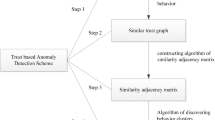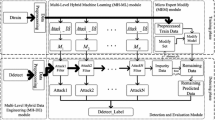Abstract
With the continuous advancement of Internet technology and the increasing number of network users, the behavior of malicious networks has become more complex and diversified, making the challenges of Internet security even more severe. Most intrusion detection systems use machine learning methods to detect user attacks, but such methods tend to be too time-intensive and inefficient when processing large amounts of data, although the accuracy for known types of attacks is high, it is not ideal for unknown attack behavior. In order to improve the situation, we propose a network anomaly behavior detection method based on affinity propagation. Firstly, we proposed the user behavior feature model by analyzing the characteristics of malicious behavior, and then we select the clustering algorithm with better performance to cluster the user behavior. Experiments show that this method can improve the accuracy and false positive rate of intrusion detection.
Access this chapter
Tax calculation will be finalised at checkout
Purchases are for personal use only
Similar content being viewed by others
References
Sun, J.Z., Zhang, Y.X., Chen, D., et al.: Effects on lifetime of opportunistic network based on epidemic routing under flooding attacks. J. Commun. 33(9), 185–190 (2012)
Zang, T.N., Yun, X.C., Zhang, Y.Z., et al.: A model of network device coordinative run. Chin. J. Comput. 34(2), 216–228 (2011)
Jiang, H., Ge, Z., Jin, S., et al.: Network prefix-level traffic profiling: characterizing, modeling, and evaluation. Comput. Netw. 54(18), 3327–3340 (2010)
Wang, Z., Xia, Q., Lu, K., et al.: An approach on detecting attack based on causality in network behavior. In: International Conference on Computer Science & Software Engineering. IEEE Computer Society (2008)
Maamar, A., Benahmed, K.: A hybrid model for anomalies detection in AMI system combining k-means clustering and deep neural network. Comput. Mater. Continua 60(1), 15–39 (2019)
Liu, J., Zeng, Y., Shi, J., et al.: A structure of encrypted malware traffic detection. Comput. Mater. Continua 60(2), 721–739 (2019)
Xiang, Yu., Tian, Z., Qiu, J., et al.: An intrusion detection algorithm based on feature graph. Comput. Mater. Continua 61(1), 255–274 (2019)
Ayday, E., Fekri, F.: Iterative Trust and Reputation Management Using Belief Propagation. IEEE Computer Society Press (2012)
Bao, F., Chen, I., Chang, M., Cho, J.: Hierarchical trust management for wireless sensor networks and its applications to trust-based routing and intrusion detection. IEEE Trans. Netw. Serv. Manage. 9(2), 169–183 (2012)
Xie, Y., Yu, S.Z.: A large-scale hidden semi-markov model for anomaly detection on user browsing behaviors. IEEE/ACM Trans. Networking 17(1), 54–65 (2009)
Feng-Yu, W., Shou-Feng, C., Jun, X., et al.: Method of detecting application-layer ddos based on the out-linking behavior of web community. J. Softw. 24(6), 1263–1273 (2013)
Frey, B.J., Dueck, D.: Clustering by passing messages between data points. Science 315(5814), 972–976 (2007)
Ng, A.Y., Jordan, M.I., Weiss, Y.: On spectral clustering: analysis and an algorithm. In: Advances in Neural Information Processing Systems, vol. 14. MIT Press (2001)
Karypis, G., Han, E.-H., Kumar, V.: Chameleon: hierarchical clustering using dynamic modeling. Computer 32(8), 68–75 (1999)
Tenenbaum, J.B.: A global geometric framework for nonlinear dimensionality reduction. Science 290(5500), 2319–2323 (2000)
Roweis, S.T.: Nonlinear dimensionality reduction by locally linear embedding. Science 290(5500), 2323–2326 (2000)
Arlitt, M.F., Williamson, C.L.: Web server workload characterization: the search for invariants. ACM SIGMETRICS Perform. Eval. Rev. 24(1), 126–137 (1996). http://ita.ee.lbl.gov/html/contrib/ClarkNet-HTTP.html
Acknowledgment
This work is supported by National Key R&D Program of China (2018YFB1402704) and the National Natural Science Foundation of China (61702048)
Author information
Authors and Affiliations
Corresponding author
Editor information
Editors and Affiliations
Rights and permissions
Copyright information
© 2020 Springer Nature Singapore Pte Ltd.
About this paper
Cite this paper
Chen, J., Guo, S., Li, W., Shen, J., Qiu, X., Shao, S. (2020). Network Abnormal Behavior Detection Method Based on Affinity Propagation. In: Sun, X., Wang, J., Bertino, E. (eds) Artificial Intelligence and Security. ICAIS 2020. Communications in Computer and Information Science, vol 1253. Springer, Singapore. https://doi.org/10.1007/978-981-15-8086-4_55
Download citation
DOI: https://doi.org/10.1007/978-981-15-8086-4_55
Published:
Publisher Name: Springer, Singapore
Print ISBN: 978-981-15-8085-7
Online ISBN: 978-981-15-8086-4
eBook Packages: Computer ScienceComputer Science (R0)




